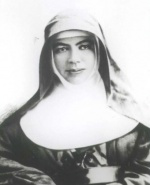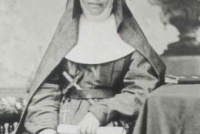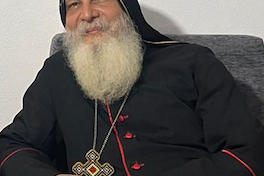Australian Catholics jubilant over news of first saint

Blessed Mary MacKillop
News of the forthcoming canonization of Blessed Mary MacKillop is being greeted with great excitement across Australia.
Sister Maria Casey, who led the Cause for Mary MacKillop's canonization, said: "Never in my wildest dreams did I think I would be the one who would see it through to the end. It's a rare privilege indeed.''
Sister Anne Derwin, Congregational Leader of the Sisters of St Joseph, the order Mary founded, said: "This is the news Australians and many others around the world have been waiting for. We are delighted that the goodness, the holiness of the life of our Australian Mary MacKillop has been recognised by the Catholic Church throughout the world."
"It is my hope that Mary's example will continue to inspire many today, especially our young people, to live with the same deep faith in God, the same hope and the same selfless charity. Mary MacKillop was a bold and pioneering woman. To her all people were
equal. To her all people deserved a fair go.Her values and endeavours symbolise and reflect what it means to be Australian. Mary MacKillop is a relevant model of holiness and service for all of us today. We look forward to celebrating this in Rome and throughout Australia, New Zealand and beyond later this year.
Mary MacKillop, the eldest of eight children of Scottish immigrants Alexander and Flora MacKillop, was born in Melbourne, Australia, on 15 January, 1842. She had an unsettled childhood. Her father dabbled in politics and business and experienced mixed fortune. The family often moved, and formal schooling was disrupted. At 14 she began work as a nursery governess and later with the stationers Sands and Kenny.
In 1860 Mary left Melbourne for the small isolated town of Penola in South Australia to act as governess for the two daughters of her father's sister, Margaret Cameron. It was there she met the local priest, Julian Tenison Woods. This was to change her life.
Australia had been settled originally as a penal colony in 1788, but by the middle of the 19th century immigrants from the British Isles were settling new farming areas. There were few schools, and children were deprived of an education. Fr Woods wanted to do something to help these children.
Fr Woods thought about an order of Australian nuns, unhampered by formal convent structures, who could move to remote areas and provide schooling. He saw in Mary MacKillop someone who could help him achieve his dream. On 19 March, 1866, the feast of St Joseph, she discarded her secular clothing and put on a simple religious habit. She was the first of the Sisters of St Joseph.
The first school was established in Penola in an old stable. Soon other young women joined her. Fr Woods composed a Rule to direct their lives, emphasizing poverty and simplicity. By the end of 1869 there were 72 sisters teaching in 21 schools as well as an orphanage and a refuge for women in distress.
Word spread to other parts of Australia, and Mary was asked to send sisters to begin schools. However, not everyone accepted this new type of religious community with its emphasis on helping the most needy in society. The sisters were denounced to Bishop Sheil in Adelaide, who responded by changing the Rule and putting himself in charge. Mary protested his interference. On 22 September, 1871, the bishop imposed on Mary a sentence of excommunication - excluding her from the sacraments of the Catholic Church. Mary's response to this was one of calm acceptance and firm trust in God. Five months later, on 23 February, 1872, only six days before he died, Bishop Sheil removed the excommunication and admitted his mistake in listening to bad advice.
The dispute about central government or control by each diocesan bishop continued for many years. The sisters were frequently the target of suspicion and opposition and were sometimes accused of incompetence as teachers. Some accused Mother Mary of drinking to excess. Bishop Reynolds, who succeeded Bishop Sheil in Adelaide, established a commission of inquiry in 1883. This prompted Mother Mary to move her motherhouse (headquarters) to Sydney, where Cardinal Moran was more supportive.
In 1888 Cardinal Moran returned from Rome with a decree from the Vatican settling the dispute. Central government was accepted as well as separate diocesan congregations. The two groups were to have different religious dress. Those who remained affiliated with the Sydney motherhouse wore brown habits, and those under the jurisdiction of the bishops wore black. From that time on the two groups have generally been known as "Brown Josephites" or Black Josephites."
The work of the sisters continued to expand, and there were new foundations throughout Australia and New Zealand. At a time when state education was becoming secular, the work of the Sisters of St Joseph helped lay the foundations for the extensive system of Catholic schools that still exists in Australia.
Mother Mary suffered a stroke in 1902. Over the next few years her health gradually deteriorated. On 4 August, 1909, Cardinal Moran visited her sick room at the motherhouse in Mount St, North Sydney. He left with the comment, "I consider this day I have assisted at the death bed of a saint." Mother Mary of the Cross died on Sunday, 8 August, 1909. At her funeral, before an enormous crowd, Cardinal Moran quoted from the Bible, from the Book of Daniel: "They that instruct many unto justice shall shine as stars for all eternity." Soon after her death people commented about her sanctity. Such was the devotion that, on 27 January, 1914, her remains were reburied in the motherhouse of the Sisters of St Joseph, where a special shrine and place of pilgrimage were constructed.
A statement on the official Mary MacKillop website says: 'Mary's public achievement is a historical fact in Australia, but for those who knew her personally the most striking thing about her was her kindness. She was a great believer in encouragement, urging people to be kind and united. In everything she said or did, she showed respect and love for those around her, making no distinction between the rich, the high-born, and the influential on the one hand, and the lowly, the jailbirds, and the outcasts of society on the other'
The Vatican accepted the biographical details of Mother Mary as evidence of exceptional virtue. In 1995 she was beatified after a first miracle was attributed to her, in which a woman was said to have been cured of terminal leukaemia. In December, Pope Benedict recognised a final miracle in which a woman's cancer cure was attributed to MacKillop.
Mary MacKillop will be canonised in a ceremony at the Vatican on 17 October. Pope Benedict XVI announced the date at a meeting of the Congregation of the Causes of Saints yesterday. It is thought she will be known as St Mary of the Cross.
For more information see: www.sosj.org.au/mary/mary.html





















